Chapter 10
mental ray Shading Techniques
A shader is a rendering node that defines the material qualities of a surface. When you apply a shading node to your modeled geometry, you use the shader’s settings to determine how the surface will look when it’s rendered. Will it appear as shiny plastic? Rusted metal? Human skin? The shader is the starting point for answering these questions. Shading networks are created when one or more nodes are connected to the channels of the shader node. These networks can range from simple to extremely complex. The nodes that are connected to shaders are referred to as textures. They can be image files created in other software packages or procedural (computer-generated) patterns, or they can be special nodes designed to create a particular effect.
The Autodesk® Maya® software comes with a number of shader nodes that act as starting points for creating various material qualities. The mental ray® plug-in also comes with its own special shader nodes that expand the library of available materials. Since the mental ray rendering plug-in is most often used to create professional images and animations, this book emphasizes mental ray techniques. You’ll learn how to use mental ray shaders to create realistic images.
In this chapter, you will learn to:
- Understand shading concepts
- Apply reflection and refraction blur
- Use basic mental ray shaders
- Apply the car paint shader
- Use the mia materials
- Render contours
Shading Concepts
Shaders are sets of specified properties that define how a surface reacts to lighting in a scene. A mental ray material is a text file that contains a description of those properties organized in a way that the software understands. In Maya, the Hypershade provides you with a graphical user interface so that you can edit and connect shaders without writing or editing the text files themselves.
The terms shader and material are synonymous; you’ll see them used interchangeably throughout this book and the Maya interface. mental ray also uses shaders to determine properties for lights, cameras, and other types of render nodes. For example, special lens shaders are applied to cameras to create effects such as depth of field.
This section focuses on shaders applied to geometry to determine surface quality. Three key concepts that determine how a shader makes a surface react to light are diffusion, reflection, and refraction. Generally speaking, light rays are reflected or absorbed or pass through a surface. Diffusion and reflection are two ways in which light rays bounce off a surface and back into the environment. Refraction refers to how a light ray is bent as it passes through a transparent surface. This section reviews these three concepts as well as other fundamentals that are important to understand before you start working with the shaders in a scene.
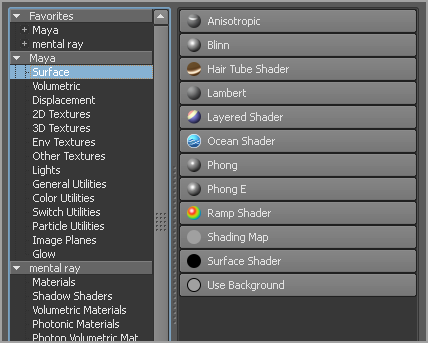

Diffusion
Diffusion describes how a light ray is reflected off a rough surface. Think of light rays striking concrete. Concrete is a rough surface covered in tiny bumps and crevices. As a light ray hits the bumpy surface, it is reflected back into the environment at different angles, which diffuse the reflection of light across the surface (see Figure 10-1).
Figure 10-1 Light rays that hit a rough surface are reflected back into the environment at different angles, diffusing light across the surface.
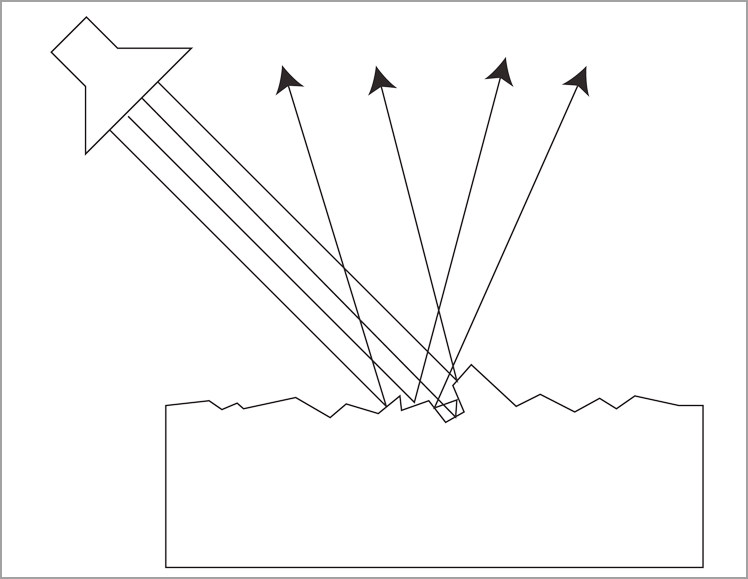
You see the surface color of the concrete mixed with the color of the lighting, but you generally don’t see the reflected image of nearby objects. A sheet of paper, a painted wall, and clothing are examples of diffuse surfaces.
In standard Maya shaders, the amount of diffusion is controlled using the Diffuse slider. As the value of the Diffuse slider is increased, the surface appears brighter because it is reflecting more light back into the environment.
Reflection
When a surface is perfectly smooth, light rays bounce off the surface and back into the environment. The angle at which they bounce off the surface is equivalent to the angle at which they strike the surface—this is the incidence angle. This type of reflection is known as a specular reflection. You can see the reflected image of surrounding objects on the surface of smooth, reflective objects. Mirrors, polished wood, and opaque liquids are examples of reflective surfaces. A specular highlight is a reflection of the light source on the surface of the object (see Figure 10-2).
Logically, smoother surfaces, or surfaces that have a specular reflectivity, are less diffuse. However, many surfaces are composed of layers (think of glossy paper) that have both diffuse and specular reflectivity.
Figure 10-2 Light rays that hit a smooth surface are reflected back into the environment at an angle equivalent to the incidence of the light angle.
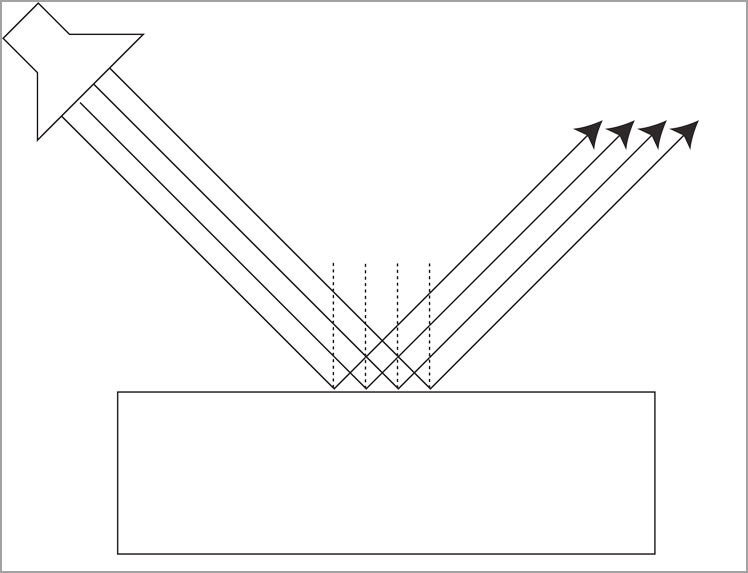
A glossy reflection occurs when the surface is not perfectly smooth but not so rough as to diffuse the light rays completely. The reflected image on a surface is blurry and bumpy and otherwise imperfect. Glossy surfaces can represent those surfaces that fit between diffuse reflectivity and specular reflectivity.
Refraction
A transparent surface can change the direction of the light rays as they pass through the surface (see Figure 10-3). The bending of light rays can distort the image of objects on the other side of the surface. Think of an object placed behind a glass of water. The image of the object as you look through the glass of water is distorted relative to an unobstructed view of the object. Both the glass and the water in the glass bend the light rays as they pass through.
Shaders use a refractive index value to determine how refractions will be calculated. The refraction index is a value that describes the amount by which the speed of the light rays is reduced as it travels through a transparent medium, as compared to the speed of light as it travels through a vacuum. The reduction in speed is related to the angle in which the light rays are bent as they move through the material. A refraction index of 1 means the light rays are not bent. Glass typically has a refractive index between 1.5 and 1.6; water has a refractive index of 1.33.
If the refracting surface has imperfections, this can further scatter the light rays as they pass through the surface. This creates a blurry refraction.
Refraction in Maya is available only when ray tracing is enabled (mental ray uses ray tracing by default). The controls for refraction are found in the Raytrace section of the Attribute Editor of standard Maya shaders. A shader must have some amount of transparency before refraction has any visible effect.
Figure 10-3 Refraction changes the direction of light rays as they pass through a transparent surface.
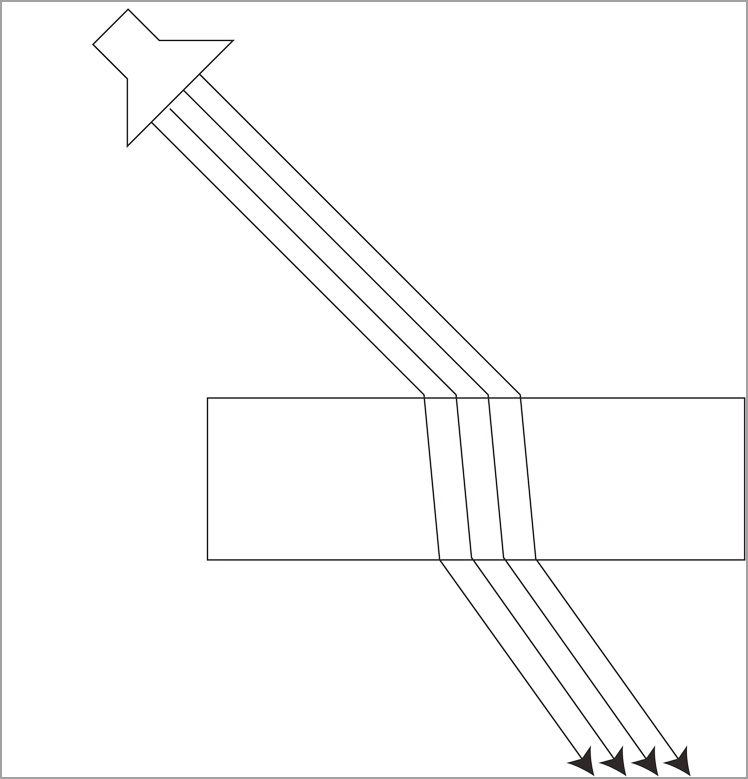
The Fresnel Effect
The Fresnel effect is named for the nineteenth-century French physicist Augustin-Jean Fresnel (pronounced with a silent s). This effect describes the amount of reflection and refraction that occurs on a surface as the viewing angle changes. The glancing angle is the angle at which you view a surface. If you are standing in front of a wall, the wall is perpendicular, and thus the glancing angle is 0. If you are on the beach looking out across the ocean, the glancing angle of the surface of the water is very high. The Fresnel effect states that as the glancing angle increases, the surface becomes more reflective than refractive. It’s easy to see objects in water as you stare straight down into water (low glancing angle); however, as you stare across the surface of water, the reflectivity increases, and the reflection of the sky and the environment makes it increasingly difficult to see objects in the water.
Opaque, reflective objects also demonstrate this effect. As you look at a billiard ball, the environment is more easily seen reflected on the edges of the ball as they turn away from you than on the parts of the ball that are perpendicular to your view (see Figure 10-4).
Figure 10-4 A demonstration of the Fresnel effect on reflective surfaces: the reflectivity increases on the parts of the sphere that turn away from the camera.

Anisotropy
Anisotropic reflections appear on surfaces that have directionality to their roughness, which causes the reflection of light to spread in one direction more than another. When you look at the surface of a compact disc, you see the tiny grooves that are created when data is written to the disc to create the satin-like anisotropic reflections. Brushed metal, hair, and satin are all examples of materials that have anisotropic specular reflections.
The resulting stretch or compression of an anisotropic reflection is defined in U and V directions. Anisotropy works in conjunction with the UV coordinates defined on a piece of geometry. (UV texture layout will be covered in Chapter 11, “Texture Mapping”).
Creating Blurred Reflections and Refractions Using Standard Maya Shaders
Standard Maya shaders, such as the Blinn and Phong shaders, take advantage of mental ray reflection and refraction blurring to simulate realistic material behaviors. These options are available in the mental ray section of the shader’s Attribute Editor. As you may have guessed, since these attributes appear in the mental ray rollout of the shader’s Attribute Editor, the effect created by these settings will appear only when rendering with mental ray. They do not work when using other rendering options, such as Maya Software.
Reflection Blur
Reflection blur is easy to use, and it is available for any of the standard Maya shaders that have reflective properties, such as Blinn, Phong, Anisotropic, and Ramp. This exercise demonstrates how to add reflection blur to a Blinn shader. This scene contains a space helmet model above a checkered ground plane.
- Many standard Maya shaders are available in the Rendering shelf. You can select an object in a scene and click one of the shader icons on the shelf. This creates a new shader and applies it to the selected object at the same time. The names of the shaders appear on the help line in the lower left of the Maya interface.
- Another way to apply a shader is to select the object in the viewport window, right-click it, and choose Assign New Material from the bottom end of the marking menu. This will open a window with a list of material bases.
- You can select the object, switch to the Rendering menu set, and choose Lighting/Shading ⇒ Assign New Material.
Figure 10-5 The reflection on the face shield is blurred in the right image.

Figure 10-6 The Reflection Blur settings are in the mental ray rollout of the shader’s Attribute Editor.

You can see how the reflection of the checkered pattern on the face shield now appears blurred.
Reflection Blur Limit sets the number of times the reflection blur itself is seen in other reflective surfaces. Increasing the Reflection Rays value increases the quality of the blurring, making it appear finer. Notice that the reflection becomes increasingly blurry as the distance between the reflective surface and the reflected object increases.
Many surfaces are more reflective than you may realize. An unpolished wooden tabletop or even asphalt can have a small amount of reflection. Adding a low reflectivity value plus reflection blurring to many surfaces increases the realism of the scene.
Refraction Blur
Refraction blur is similar to reflection blur. It blurs the objects that appear behind a transparent surface that uses refraction. This gives a translucent quality to the object.
Figure 10-7 The image of the face is refracted by the surface of the face shield (left image). The refracted image is then blurred (right image).

To see a version of the scene, open the reflectionBlur_v02.ma file from the chapter10scenes folder at the book’s web page.
Refraction Blur Limit sets the number of times the refraction blur itself will be seen in refractive surfaces. Increasing the value of Refraction Rays increases the quality of the blurring, making it appear finer.
Basic mental ray Shaders
mental ray has a number of shaders designed to maximize your options when creating reflections and refractions, as well as blurring these properties. Choosing a shader should be based on a balance between the type of the material you want to create and the amount of time and processing power you want to devote to rendering the scene.
This section looks at a few of the shaders available for creating various types of reflections and refractions. These shaders are by no means the only way to create reflections and refractions. As discussed in previous sections, standard Maya shaders also have a number of mental ray–specific options for controlling reflection and refraction.
Once again, remember to think of mental ray as a big toolbox with lots of options. The more you understand about how these shaders work, the easier it will be for you to decide which shaders and techniques you want to use for your renders.
DGS Shaders
Diffuse Glossy Specular (DGS) shaders have simple controls for creating different reflective qualities for a surface as well as additional controls for transparency and refraction. The reflections and refractions created by this shader are physically accurate, meaning that, at render time, mental ray simulates real-world light physics as much as possible to create the look seen in the render.
The scene has a simple light setup. The key lighting is provided by a mental ray area light, which can be seen as a specular highlight on the orange metal of the helmet and on the glass face shield. The fill lighting is supplied by two directional lights; these lights have their specularity turned off so that they are not seen as reflections on the surface of the helmet (see Figure 10-8).
Figure 10-8 The space helmet rendered with simple lighting and standard Maya shaders
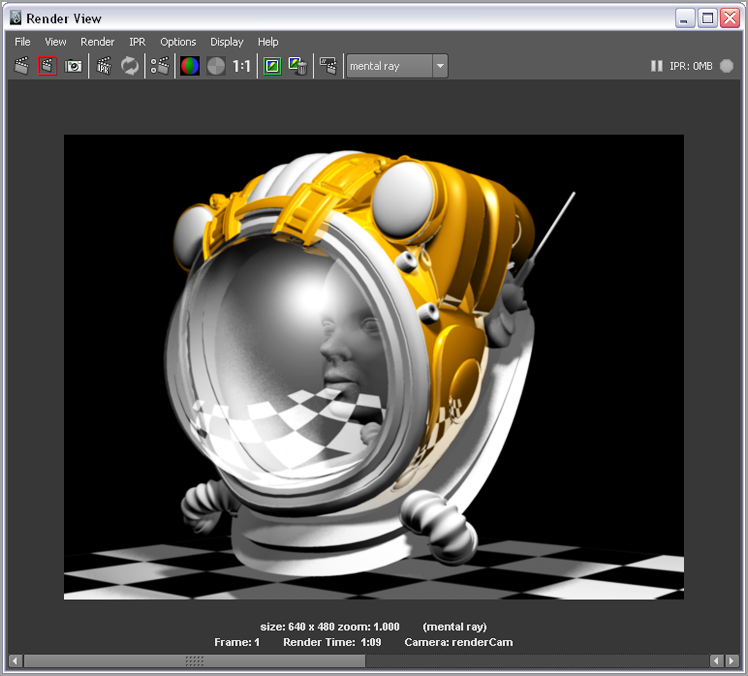
The helmet uses standard Maya shaders. The metal of the helmet uses an orange Blinn, the face shield uses a transparent Blinn, and the helmet details and the woman’s head use Lambert shaders. The grainy quality of the shadows results from the low sampling level set for the area light. By keeping the samples low, the image renders in a fairly short amount of time. The reflection of the checkerboard plane beneath the helmet is clearly seen in the metal of the helmet and on the face shield.
If you compare Figure 10-9 to Figure 10-8, you should notice a few details:
- The surfaces are reflective; however, there is no specular highlight (reflection of the light source) on either the helmet surfaces or the glass shield in Figure 10-9.
- The shadow of the face shield that falls on the checkered floor is not transparent in Figure 10-9, but it is transparent in Figure 10-8.
Figure 10-9 The helmet and face shield surfaces have DGS shaders applied.
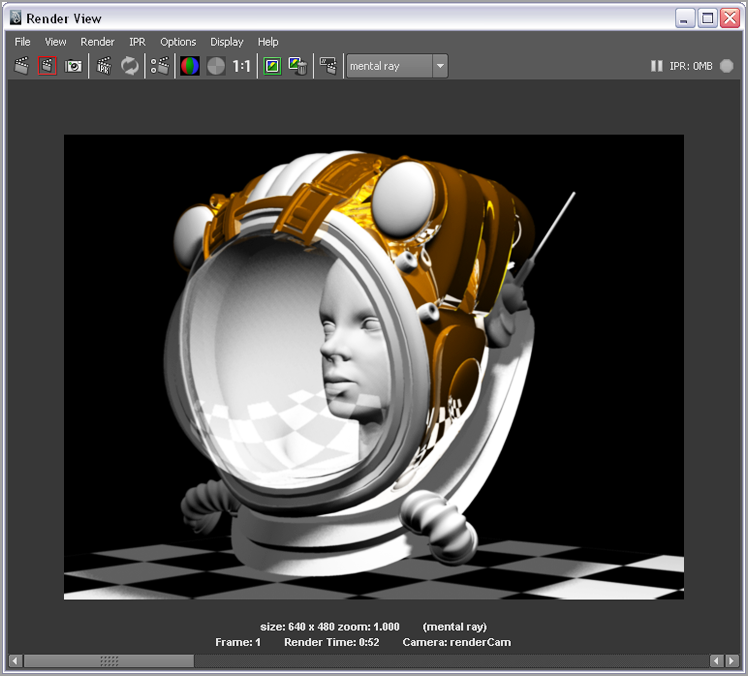
Let’s look at how to solve these problems. The shader is meant to be physically accurate. The Specular attribute refers to the reflectivity of the shader. In standard Maya shaders, reflectivity and specularity are separated (however, increasing one affects the intensity of the other). But in the DGS shader attributes, the Specular channel controls the reflection of visible objects, so a light source must be visible to be seen in the specular reflections.
Glossy reflections, on the other hand, automatically render the reflection of a light source regardless of whether the light source is set to Visible. The Glossy attribute on the DGS shader controls how reflections are scattered across the surface of an object. The term specular highlight with regard to shading models implies a certain amount of glossiness. Understandably, it’s confusing when talking about specular reflections and specular highlights as two different things. The bottom line is this: to make a specular highlight appear in a DGS shader, either the light has to be visible when the Specular attribute is greater than 0 and Glossy is set to 0 or the Glossy setting must be greater than 0 (that is, not black).
Glossy reflections can be blurry or sharp. To control the blurriness of a glossy reflection, you need to adjust the Shiny setting. Lower Shiny values create blurry reflections; higher Shiny values create sharp reflections.
Figure 10-10 Rendering using different settings for the DGS materials applied to the helmet metal and face shield
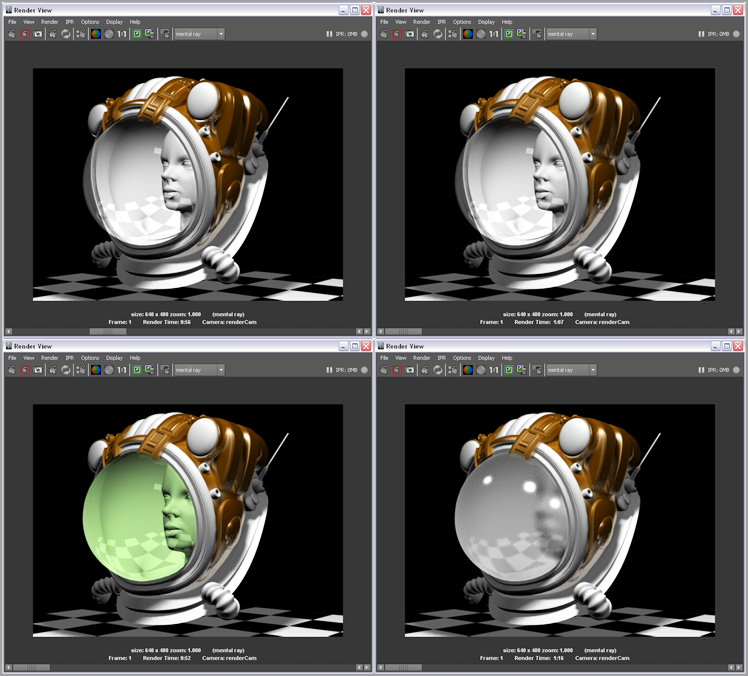
The Shiny U and Shiny V settings simulate the anisotropic reflections on the material by stretching the reflection along the U or V direction. In this case, this is not physically accurate and does not simulate how tiny grooves in the surface affect the reflection.
When rendering transparent surfaces using the DGS shader, the Specular, Glossy, Transparency, and Refraction settings all work together to create the effect. For transparency to work, the shader must have a Transparency setting higher than 0 and either a Specular or a Glossy setting greater than 0. If Transparency is set to 1, and both Specular and Glossy are set to black, the surface will render as opaque, the same as if Transparency were set to 0.
The Specular color can be used to color the transparent surface, and the Glossy setting can be used (along with the Shiny settings) to create the look of a translucent material, such as plastic, ice, or frosted glass:
A few details are worth noting about using the Glossy settings:
- Specular reflections of all the lights in the scene are visible on the surface when Glossy is greater than 0. Notice that the highlights of the two directional lights are visible in the glass even though the Specularity option for both lights is disabled. To avoid this, consider using Global Illumination or Final Gathering to create fill lighting in the scene. (See Chapter 9 for information on these techniques.)
- Glossy reflections and refractions are physically accurate in that objects close to the refractive or reflective surface will appear less blurry than objects that are farther away.
- To make an object look more metallic, tint the Glossy color similar to the Diffuse color.
- Try using textures in the Glossy and Specular channels to create more interesting materials.
- When using the shader on scenes that employ Global Illumination, you need to create a dgs_material_photon node (found in the Photonic Materials section of the mental ray render nodes of the Hypershade). Attach this shader to the shading group of the original DGS material in the Photon Shader slot, and then use the settings on the dgs_material_photon node to control the shader.
- You can increase realism further by rendering a separate reflection occlusion pass to use in a composite (render passes are covered in Chapter 12, “Rendering for Compositing”) or plug occlusion textures into the specular and glossy attributes (enable Reflection on the occlusion textures).
To see a finished version of the scene, open the helmet_v02.ma scene from the chapter10scenes folder at the book’s web page.
Dielectric Material
The purpose of the Dielectric material is to simulate the refraction of light accurately as it passes through transparent materials such as glass, water, and other fluids. The term dielectric refers to a surface that transmits light through multiple layers, redirecting the light waves as they pass through each layer.
If you observe a fish in a glass bowl, you’ll see that the light rays that illuminate the fish in the bowl transition from air to glass, then from glass to water, then again from water back to glass, and finally from glass out into the air on the other side. Each time a light ray makes a transition from one surface to another, the direction of the light ray changes. The index of refraction describes the change in the light ray’s direction.
Most standard materials in Maya use a single index of refraction value to simulate the change of direction of the light ray as it is transmitted through the surface. This is not accurate, but it’s usually good enough to create a believable effect. However, if you need to create a more physically accurate refractive surface, the Dielectric material is your best choice. This is because it has two settings for the index of refraction that describes the change of the light ray’s direction as it makes a transition from one refractive surface to the next.
In this exercise, you’ll create a physically accurate rendering of a glass of blue liquid using the Dielectric material. Light will move from the air into glass and then from the glass into the water. The glass is open at the top, so you’ll also need to simulate the transition from air to water. This means you’ll need to use three Dielectric materials: one for air to glass, one for glass to water, and one for air to water. This tutorial is based on Boaz Livny’s discussion of the Dielectric material in mental ray for Maya, 3ds Max, and XSI (Sybex, 2008).
In this scene, a simple glass has been modeled and split into four surfaces, named air_glass1, air_glass2, liquid_glass1, and liquid_air1. Each surface represents one of the three transitions that will be simulated using the Dielectric material. To make this easier to visualize, we applied a colored Lambert shader to each surface. The scene is lit using a single spotlight that casts raytrace shadows.
Figure 10-11 Use the menu in the Color Chooser to set the mode to HSV.

Figure 10-12 Render the glass using the Dielectric material (left image). Add transparent shadows by rendering with caustics (right image).

To see a version of the scene, open the glass_v02.ma scene from the chapter10scenes folder at the book’s web page.
You can see that there are differences between the refractions of the various surfaces that make up the glass and the water. Just like the DGS shader, the Dielectric material fails to cast transparent shadows (the left image of Figure 10-12). The best solution for this problem is to enable Caustics. When enabling Caustics with the Dielectric shader, you need to connect a dielectric_material_photon material to the Photon Shader slot of the Shading Group node and enable Caustics. The settings for the dielectric_material_photon material should be the same as the settings for the Dielectric material.
The image on the right of Figure 10-12 shows the glass rendered with Caustics enabled. Using Caustics is explained in Chapter 9. To see an example of this setup, open the dielectricCaustics.ma scene in the chapter10scenes folder at the book’s web page.
mental ray Base Shaders
A number of shaders available in the Hypershade are listed with the prefix mib (mental images base): mib_illum_cooktorr, mib_illum_blinn, and so on. These are the mental ray base shaders. You can think of these nodes as building blocks; you can combine them to create custom mental ray shaders to yield any number of looks for a surface. There are far too many to describe in this chapter, so it’s more important that you understand how to work with them. Descriptions of each node are available in the mental ray user guide that is part of the Maya documentation.
In this exercise, you’ll see how a few of these shaders can be combined to create a custom material for the helmet:
Figure 10-13 The mental ray base shaders are available in the Legacy Materials section of the Create mental ray Nodes menu.

If you have a hard time discerning the color in the highlight from the color of the diffuse component, set Diffuse to black and create another test render.
The helmet has a convincing metallic look, but you’ll notice that there are no reflections. To add reflections, you can combine the Cook-Torrance shader with a glossy reflection node:
Figure 10-14 The Cook-Torrance shader creates fairly realistic metallic highlights.

Figure 10-15 Connect the Cook-Torrance shader to the Base Material slot of the mib_glossy_reflection1 node.

Figure 10-16 The combination of the two materials creates a reflective metal for the helmet.

The U Spread and V Spread sliders control the glossiness of the reflections, much like the Shiny U and Shiny V settings on the DGS shader. Higher values produce glossier reflections. Using a different value for U than V creates anisotropic specular highlights. Ideally, you want to match the glossiness of the reflections on the mib_glossy_reflection1 shader with the glossiness of the highlight on the mib_cooktorr shader.
You can blend between a reflection of the objects in the scene and an environment reflection. To do this, you first need to create an environment reflection node:
Figure 10-17 The mib_lookup_background1 node is connected to the Environment field of the mib_glossy_reflection1 node.

Figure 10-18 Select the desert.jpg image to use in the mentalrayTexture1 node. This image will appear reflected in the metal of the helmet.
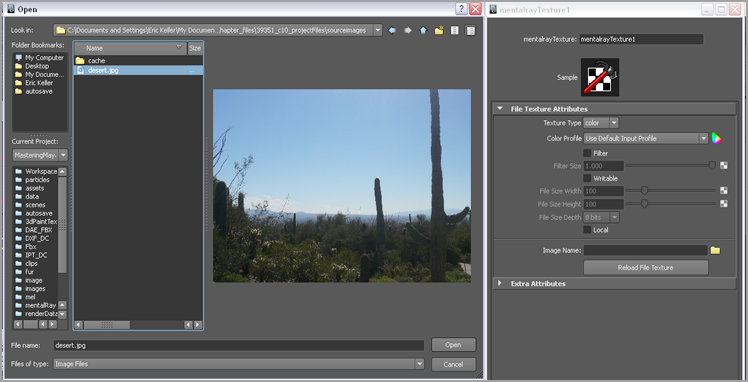
Figure 10-19 The blue sky of the desert image colors the reflections on the metal of the helmet.

To increase the realism of the reflections, you can add an ambient occlusion node to decrease the intensity of the reflections in the crevices of the model. Using ambient occlusion is discussed in Chapter 9. In this example, the mib_ambient_occlusion node is used as part of the helmet shader network:
Figure 10-20 Adding an ambient occlusion node to control the reflectivity on the surface of the helmet helps to add realism to the render.

Figure 10-21 shows the shader network for this material.
Figure 10-21 The mental ray base shaders are connected to create a realistic painted-metal surface for the helmet.
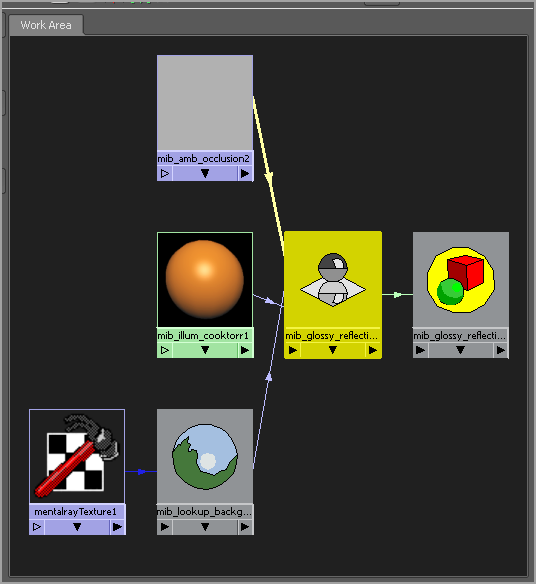
This gives you an idea of how to work with the mental ray base materials. Of course, you can make many more complex connections between nodes to create even more realistic and interesting surface materials. Experimentation is a good way to learn which connections work best for any particular situation.
To see a version of the scene up to this point, open the helmet_v04.ma scene from the chapter10scenes folder at the book’s web page.
Car Paint Materials
Simulating the properties of car paint and colored metallic surfaces is made considerably easier thanks to the special car paint phenomenon and metallic paint mental ray materials.
In reality, car paint consists of several layers; together these layers combine to give the body of a car its special, sparkling quality. Car paint uses a base-color pigment, and the color of this pigment changes hue depending on the viewing angle. This color layer also has thousands of tiny flakes of metal suspended within it. When the sun reflects off these metallic flakes, you see a noticeable sparkling quality. Above these layers is a reflective clear coat, which is usually highly reflective (especially for new cars) and occasionally glossy. The clear coat itself is a perfect study in Fresnel reflections. As the surfaces of the car turn away from the viewing angle, the reflectivity of the surface increases.
The metallic paint material is similar to the car paint phenomenon material. In fact, you can re-create the car paint material by combining the mi_metallic_paint node with the mi_glossy_reflection node and the mi_bump_flakes node.
In this section, you’ll learn how to use the car paint material by applying it to the tractorDroid model created for this book by designer Anthony Honn.
Figure 10-22 The car paint materials are in the Materials section of the mental ray Nodes section in the Hypershade.
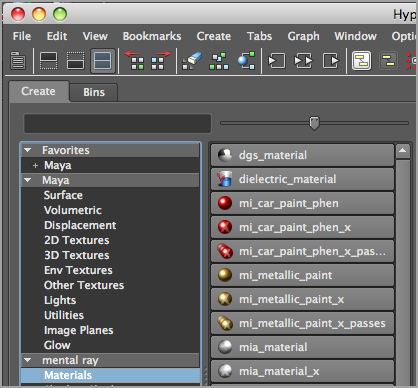
Figure 10-23 Use the Hypershade marking menu to select the parts of the model that use the body_shader material.

Figure 10-24 Use the Hypershade marking menu to assign the mi_car_paint_phen_x shader.

Figure 10-25 The settings for the car paint shader
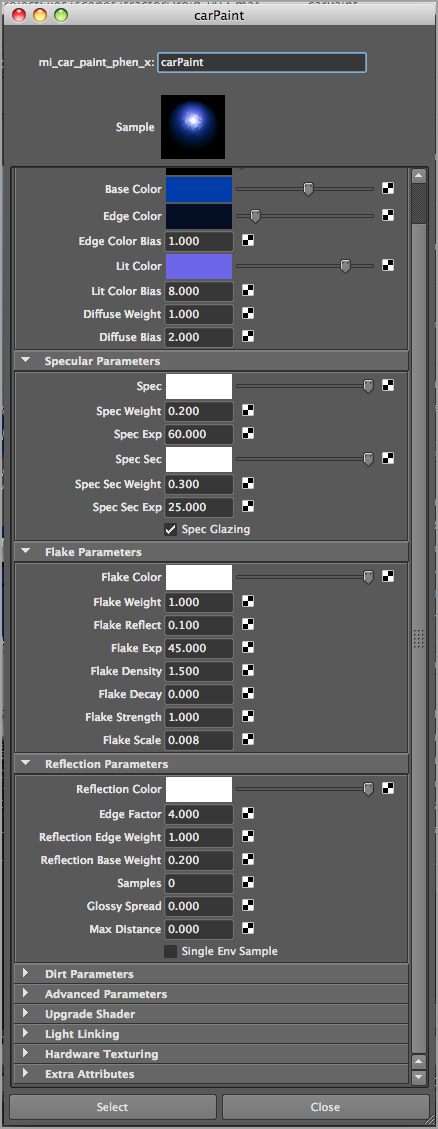
Diffuse Parameters
At the top of the attributes, you’ll find the Diffuse Parameters rollout. The settings here determine the color properties of the base pigment layer. As the color of this layer changes depending on the viewing angle, the various settings determine all the colors that contribute to this layer.
Specular Parameters
The Specular Parameters settings define the look of the specular highlight on the surface. In this particular shader, these settings are separate from the Reflection Parameters settings. By adjusting the settings in Specular Parameters, you can make the car paint look brand-new or old and dull.
Here is how the settings work:
- When rendered, the specular highlight has two components: a bright center highlight and a surrounding secondary highlight. Spec Weight and Spec Sec Weight are multipliers for the primary specular and secondary specular colors (respectively).
- Spec Exp and Spec Sec Exp determine the tightness of the highlight; higher values (30 and greater) produce tighter highlights. Generally, Spec Sec Exp should be less than Spec Exp.
- The Spec Glazing check box at the bottom of the Specular Parameters section adds a polished shiny quality to the highlight, which works well on new cars. Turn this feature off when you want to create the look of an older car with a duller finish.
For our next exercise, you can leave the specular parameters at their default settings.
Flake Parameters
The Flake Parameters settings are the most interesting components of the shader. These determine the look and intensity of the metallic flakes in the pigment layer of the car paint:
For this exercise, use the following settings:
Reflection Parameters
The Reflection Parameters settings are similar to those for the reflection parameters on the glossy reflection material. The reflectivity of the surface is at its maximum when Reflection Color is set to white. When this option is set to black, reflections are turned off.
Once you’ve familiarized yourself with the reflectivity settings, follow these steps:
Figure 10-26 The car paint material is applied to the body of the car and rendered with the Physical Sun and Sky lighting model.
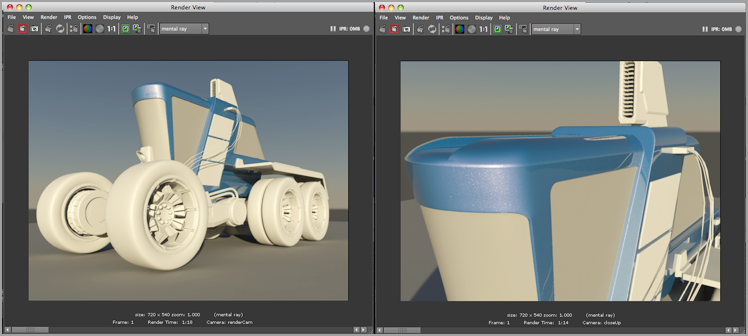
To see a finished version of the scene, open the tractorDroid_v02.ma file from the chapter10scenes folder at the book’s web page.
The mia Material
The mia material is the Swiss Army knife of mental ray shaders. It is a monolithic material, meaning that it has all the functionality needed for creating a variety of materials built into a single interface. You don’t need to connect additional shader nodes into a specific network to create glossy reflections, transparency, and the like.
mia stands for mental images architectural, and the shaders (mia_material, mia_material_x, mia_material_passes) and other lighting and lens shader nodes (mia_physicalsun, mia_portal, mia_exposure_simple, and so on) are all part of the mental images architectural library. The shaders in this library are primarily used for creating materials used in photorealistic architectural renderings; however, you can take advantage of the power of these materials to create almost anything you need.
The mia material has a large number of attributes that at first can be overwhelming. However, presets are available for the material. You can quickly define the look you need for any given surface by applying a preset. Then you can tune specific attributes of the material to get the look you need.
Using the mia Material Presets
The presets that come with the mia material are the easiest way to establish the initial look of a material. Presets can also be blended to create novel materials. Furthermore, once you create something you like, you can save your own presets for future use in other projects. You’ll work on defining materials for the space helmet. Just like the example in the previous section, this version of the scene uses the mia_physicalsunsky lighting network and Final Gathering to light the scene.
You can tweak many of the settings to create your own custom metal, and already it looks pretty good. Like with the other materials in this chapter, the Glossiness setting adds blur to the reflections. Turning on Highlights Only creates a more plastic-like material—with this option activated, the Reflection settings apply only to specular highlights.
Next you can add chrome to the helmet:
Figure 10-27 The mia material comes with a number of presets that can be blended together to create novel materials. For example, blending the Copper and SatinedMetal presets creates a convincing metallic surface.

Add Bumps to the Rubber Shader
The rubber shader can use a little tweaking. A slight bumpiness can increase the realism. The mia_material has two slots for bump textures under the Bump rollout; they’re labeled Standard Bump and Overall Bump. Standard Bump works much like the bump channel on a standard Maya shader (Blinn, Lambert, Phong, and so on). Overall Bump is used primarily for the special mia_roundcorners texture node, which is explained in the next section.
When using a texture to create a bump effect, connect the texture to the Standard Bump slot, as demonstrated in this exercise:
Figure 10-28 The Leather texture is added as a bump to the rubber mia material.
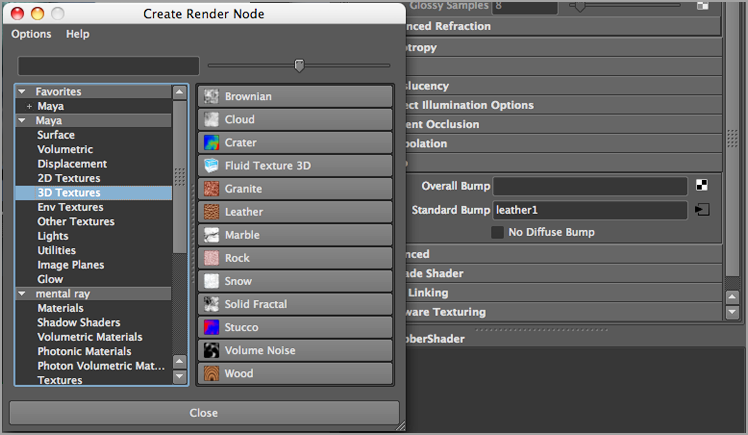
You’ll notice that in the Bump rollout there is a No Diffuse Bump check box. When a texture is connected to the Standard Bump field and No Diffuse Bump is activated, the bump appears only in the specular and reflective parts of the material, which can be useful for creating the look of a lacquered surface.
Figure 10-29 The bump adds realism to the rubber parts of the helmet.

Create Beveled Edges Using mia_roundcorners
A very slight edge bevel on the corners of the model can improve the realism of the model. (Sharp edges on a surface are often a telltale sign that the object is computer generated.) Usually, this bevel is created in the geometry, which can add a lot of extra vertices and polygons. The mia_roundcorners texture adds a slight bevel to the edges of a surface that appears only in the render, which means that you do not need to create beveled edges directly in the geometry.
The mia_roundcorners texture is attached to the Overall Bump channel of the mia_material. The reason the mia_material has two bump slots is so that you can apply the roundcorners texture to the Overall Bump shader and another texture to the Standard Bump shader to create a separate bumpy effect.
Let’s take a look at the roundcorners texture in action by applying it to the chrome material:
Figure 10-30 Adding the mia_roundcorners texture to the chromeShader’s Overall Bump channel creates a slight beveled edge, as is demonstrated by the right render. Compare the edges to the left image, which does not have this beveled effect applied.

To see a version of the scene, open the helmet_v06.ma scene from the chapter10scenes folder at the book’s web page.
Creating Thick and Thin Glass and Plastic
Another feature of the mia_material shader is the ability to simulate thickness and thinness in the material itself without creating extra geometry. This can be very useful, especially for glass surfaces.
The lamps at the top of the helmet have a chrome reflector behind the thick glass, which adds to the reflectivity of the material. The settings to control thickness are found under the Advanced Refractions controls. Along with the standard Index Of Refraction setting, there is an option for making the material either thin-walled or solid. You also have the option of choosing between a transparent shadow and a refractive caustic that is built into the material (the caustics render when caustic photons are enabled and the light source emits caustic photons; for more information on caustics, consult Chapter 9).
Figure 10-31 Apply the glass and plastic presets to parts of the helmet.

To see a finished version of the scene, open the helmet_v07.ma scene from the chapter10scenes folder at the book’s web page.
Other mia Material Attributes
The mia_material has a lot of settings that can take some practice to master. It’s a good idea to take a look at the settings used for each preset and note how they affect the rendered image. Over time, you’ll pick up some good tricks using the presets as a starting point for creating your own shaders. The following sections give a little background on how some of the other settings work.
Built-in Ambient Occlusion
The Ambient Occlusion option on the material acts as a multiplier for existing ambient occlusion created by the indirect lighting (Final Gathering/Global Illumination). The Use Detail Distance option in the Ambient Occlusion section can be used to enhance fine detailing when set to On. When Use Detail Distance is set to With Color Bleed, the ambient occlusion built into the mia_material factors the reflected colors from surrounding objects into the calculation.
Translucency
The Translucency setting is useful for simulating thin objects, such as paper, that allow some amount of light to pass through them. This option works only when the material has some amount of transparency. The Translucency Weight setting determines how much of the Transparency setting is used for transparency and how much is used for translucency. So if Transparency is 1 (and the transparency color is white) and Translucency Weight is 0, the object is fully transparent (see Figure 10-32, left). When Translucency Weight is at 0.5, the material splits the Transparency value between transparency and translucency (Figure 10-32, center). When Translucency Weight is set to 1, the object is fully translucent (Figure 10-32, right).
Notice that you can also create translucent objects by experimenting with the glossiness in the Refraction settings. This can be used with or without activating the Use Translucency option. If you find that the translucency setting does not seem to work or make any difference in the shading, try reversing the normals on your geometry (in the Polygons menu set, choose Normals ⇒ Reverse). The mia materials have a wide variety of uses beyond metal and plastic. The materials offer an excellent opportunity for exploration. For more detailed descriptions of the settings, read the mental ray for Maya Architectural Guide in the Maya documentation.
Figure 10-32 Three planes with varying degrees of translucency applied

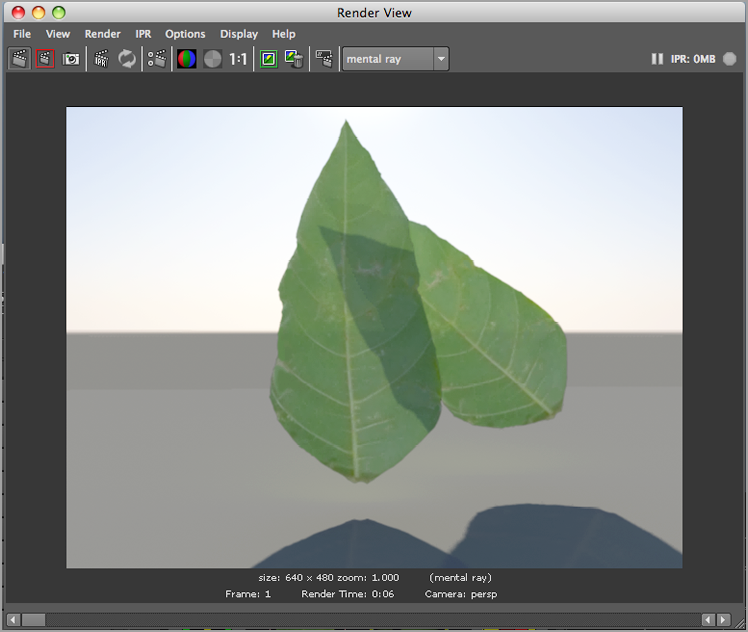
- Make sure the normals of your polygon objects are facing in the correct direction.
- Make sure the file texture you use for Cutout Opacity has an alpha channel.
- Make sure that the Transparency setting is above 0 in order for the translucency to work.
Controlling Exposure with Tone Mapping
Tone mapping refers to a process in which color values are remapped to fit within a given range. Computer monitors lack the ability to display the entire range of values created by physically accurate lights and shaders. This becomes apparent when using HDRI lighting, mia materials, and the physical light shader. Using tone mapping, you can correct the values to make the image look visually pleasing when displayed on a computer monitor.
Lens shaders are applied to rendering cameras in a scene. Most often, they are used for color and exposure correction. You’ve already been using the mia_physicalsky lens shader, which is created automatically when you create the Physical Sun and Sky network using the controls in the Indirect Lighting section of the Render Settings window.
The mia_exposure_photographic and mia_exposure_simple shaders are used to correct exposure levels when rendering with physically based lights and shaders. The mia_exposure_photographic lens shader has a lot of photography-based controls that can help you correct the exposure of an image. The mia_exposure_simple lens shader is meant to accomplish the same task; however, it has fewer controls and is easier to set up and use. In this exercise, you’ll use the mia_exposure_simple lens shader to fix problems in a render.
The scene you’ll use is the space helmet scene. This version of the scene uses the same mia_materials as the previous section. In the previous section, the problems with the exposure were not noticeable because lens shaders were already applied to all the cameras when the Physical Sun and Sky network was created. In this section, you’ll learn how to apply the lens shader manually:
Figure 10-33 The image on the left appears underexposed; adding a lens shader to control exposure fixes the problem, as shown in the image on the right.

To see a finished version of the scene, open the helmet_v09.ma scene from the chapter10scenes folder at the book’s web page.
The following is a brief description of the mia_exposure_simple shader’s attributes:
For a more in-depth discussion of tone mapping, consult the mental ray for Maya Architectural Guide included in the Maya documentation.
Rendering Contours
mental ray has a special contour-rendering mode that enables you to render outlines of 3D objects. This is a great feature for non-photorealistic rendering. You can use it to make your 3D animations appear like drawings or futuristic computer displays. The end title sequence of the film Iron Man is a great example of this style of rendering.
Rendering contours is easy, but it requires activating settings in several places. Furthermore, it is not supported by Unified Sampling. The Legacy Sampling mode must be used. The following steps take you through the process of rendering with contours:
Figure 10-34 To render contour lines, you must select Enable Contour Rendering and choose a Draw By Property Difference option.
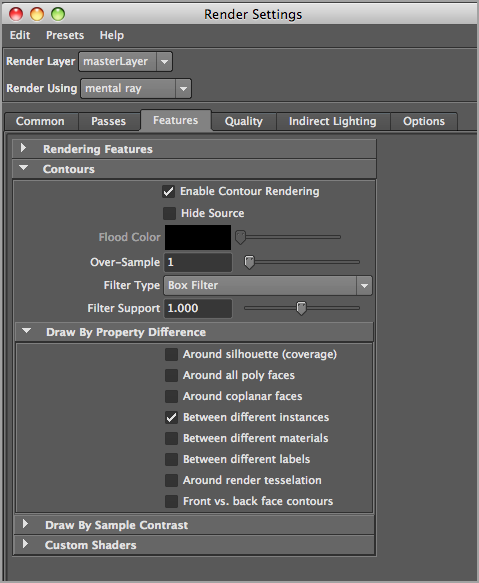
Figure 10-35 Contour Rendering also needs to be enabled in the shader’s shading group node settings.
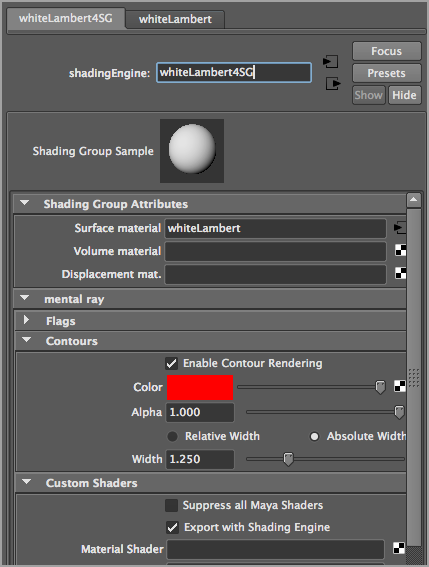
Figure 10-36 Contour rendering creates lines on top of the rendered surface. In the right image, the source has been hidden, so only the lines render.
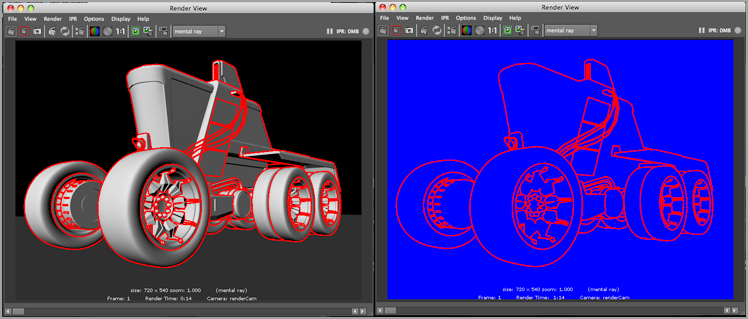
This time the original geometry is hidden, and only the contours are rendered. Flood Color determines the background color when Hide Source is activated. Oversampling sets the quality and antialiasing of the contour lines. To see a finished version of the scene, open the tractorDroidContour_v02.ma scene from the chapter10scenes folder at the book’s web page.
You can adjust the width of the contours using the controls in the Contours section of the shading group. Absolute Width ensures that the contours are the same width; Relative Width makes the width of the contours relative to the size of the rendered image.
Since each shading group node has its own contour settings, you can create lines of differing thickness and color for all the parts of an object. Just apply different materials to the different parts, and adjust the settings in each material’s shading group node accordingly.
Experiment using different settings in the Draw By Property Difference section of the Render Settings window. More complex contour effects can be created by plugging one of the contour shaders available in the Create mental ray Node section of the Hypershade into the Contour Shader slot under the Custom Shaders section of the shading group node.
